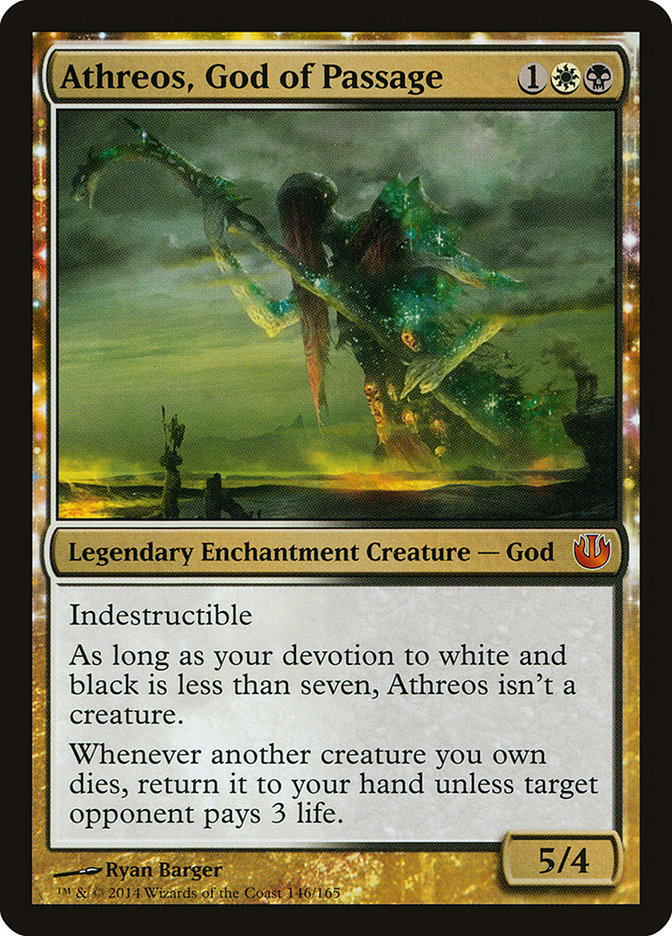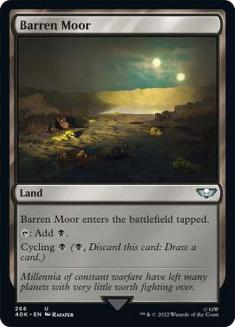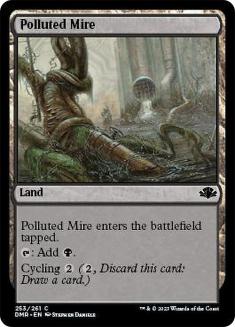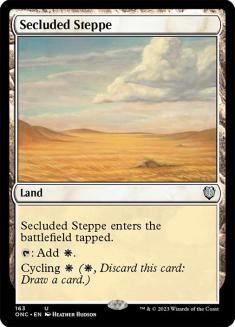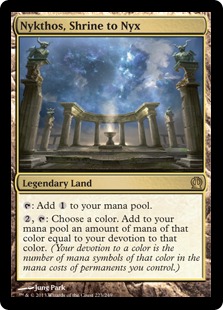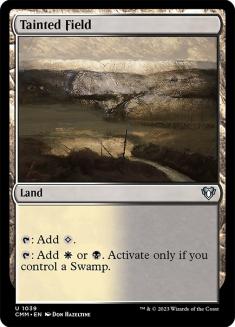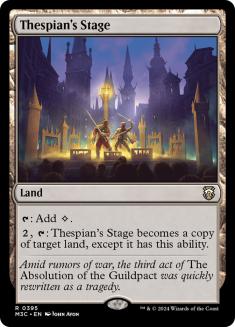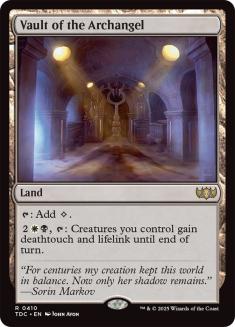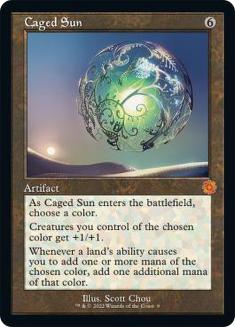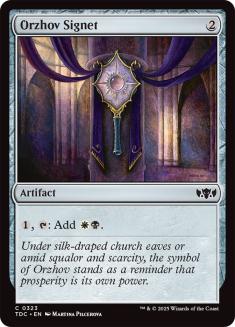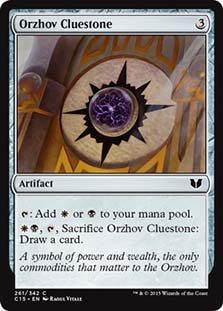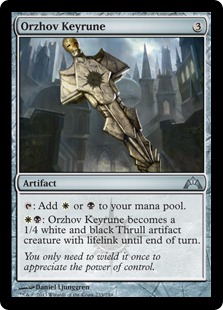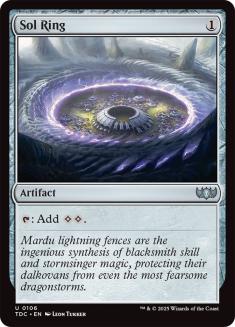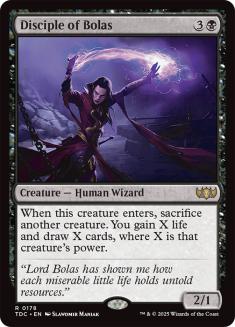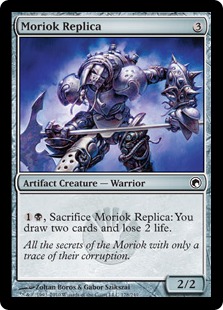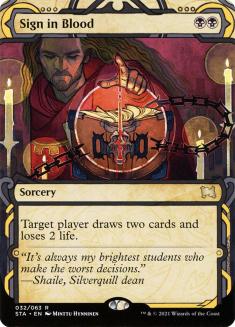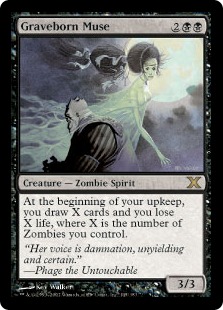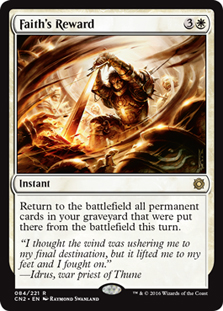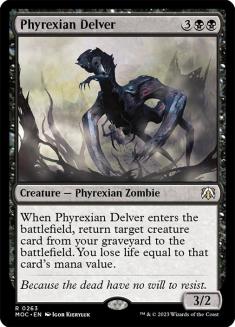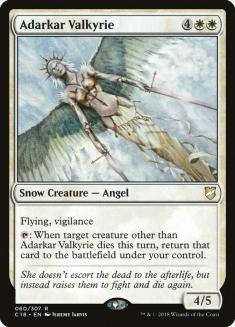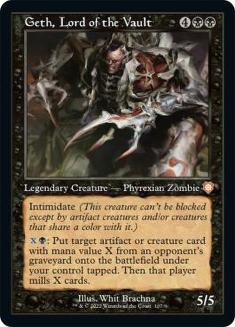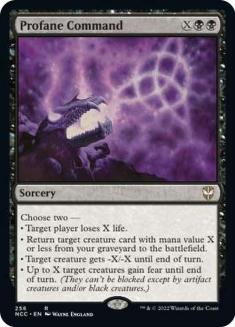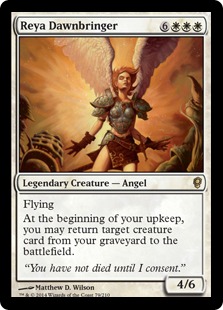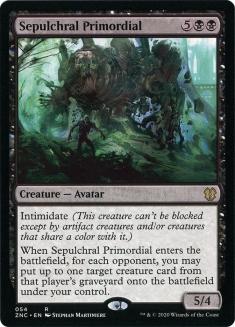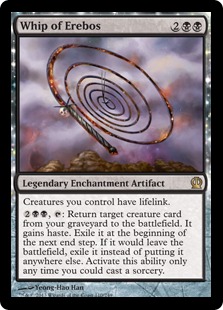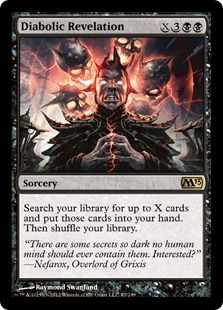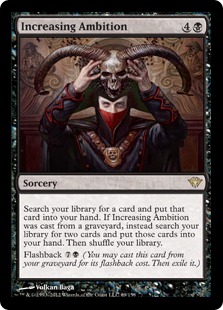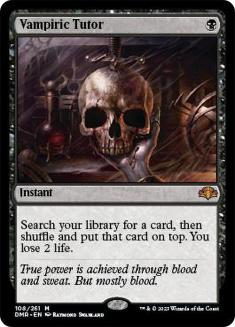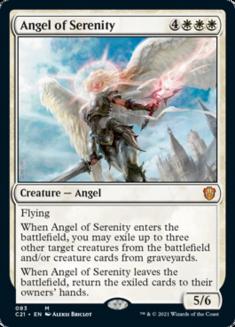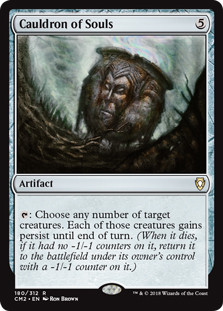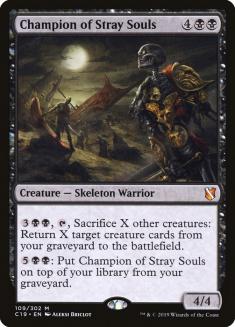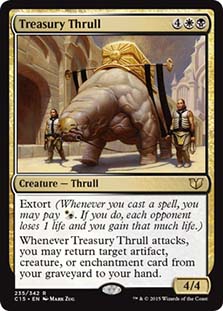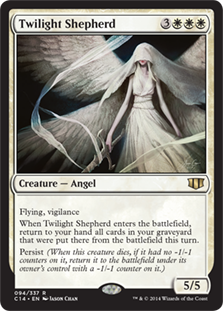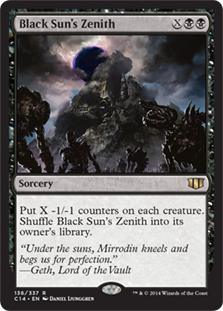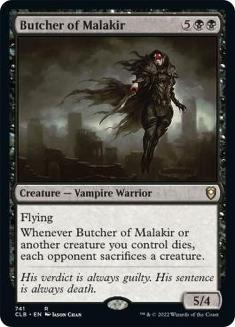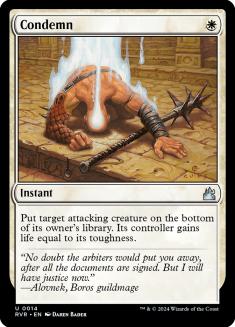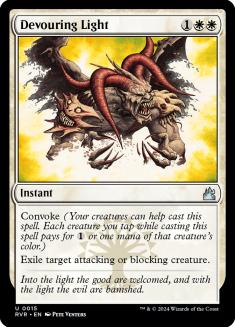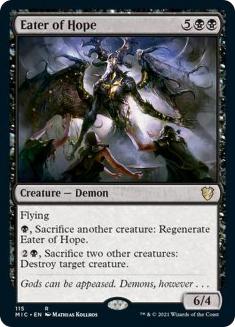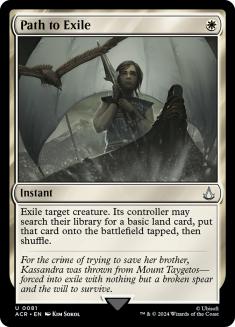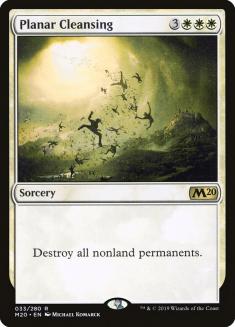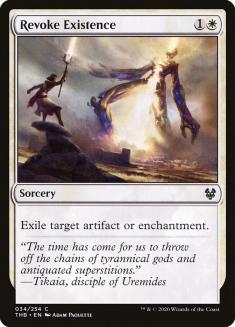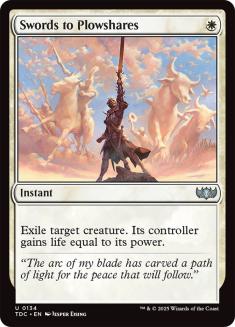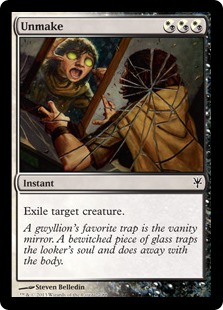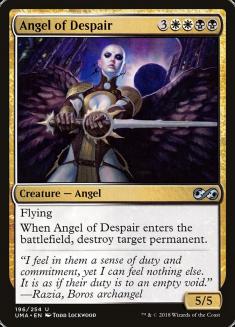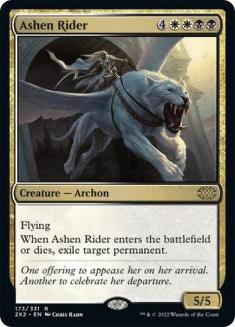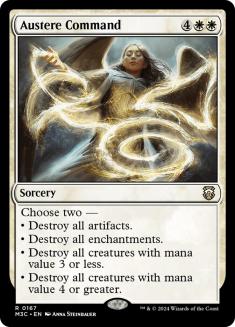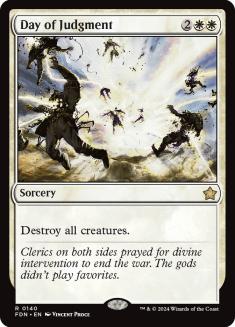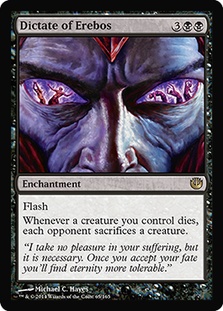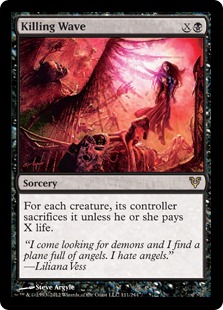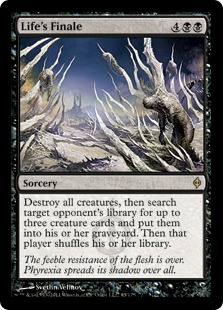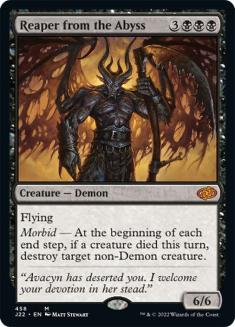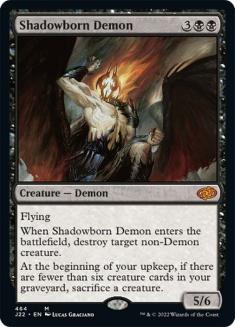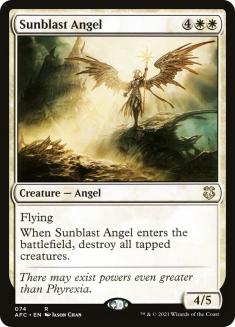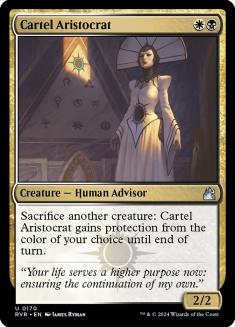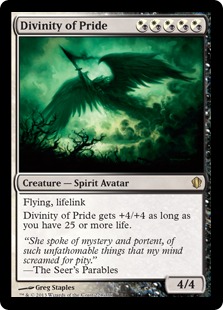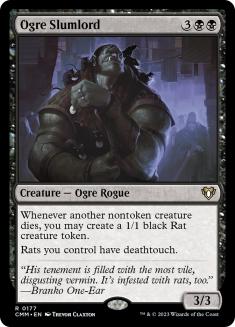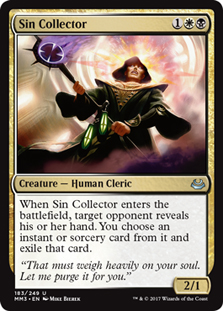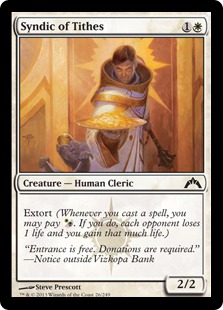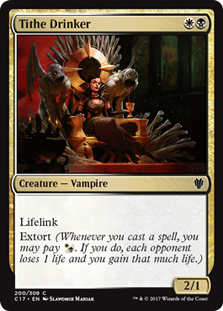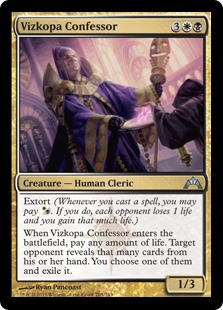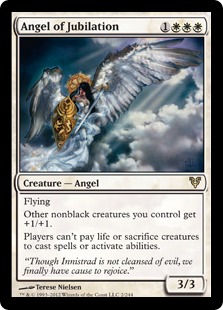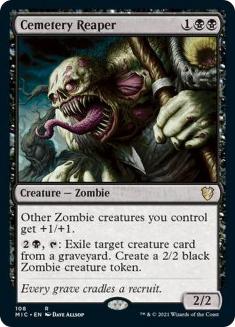Themed Commander decks are like shooting the moon in Hearts. It’s hard to do, and there are plenty of ways for the wheels to fall off, but there’s nothing better than that feeling when it all comes together into something as playable as it is flavorful. For a while I was playing around with the idea of a crudely-themed Commander deck based around Athreos, Gott der Überfahrt, with cards like Hissing Miasma in a starring role, but an extended fart joke is hard to maintain over 100 cards. It’s also really childish, but that’s less of a concern.
Athreos, God of Passage is ripe for a serious, flavorful take though. Charon (Χάρων for Classics majors), the boatman on the River Styx in the Greek mythology upon which Theros is based, taps into something primal in the way we visualize life and death. If life is a place, and death is a place, there has to be something special about the border, right? Otherwise we’d still be neck deep in the dead! And if there is some sort of impenetrable border between the two, you need a psychopomp to navigate it, or else people could never die.
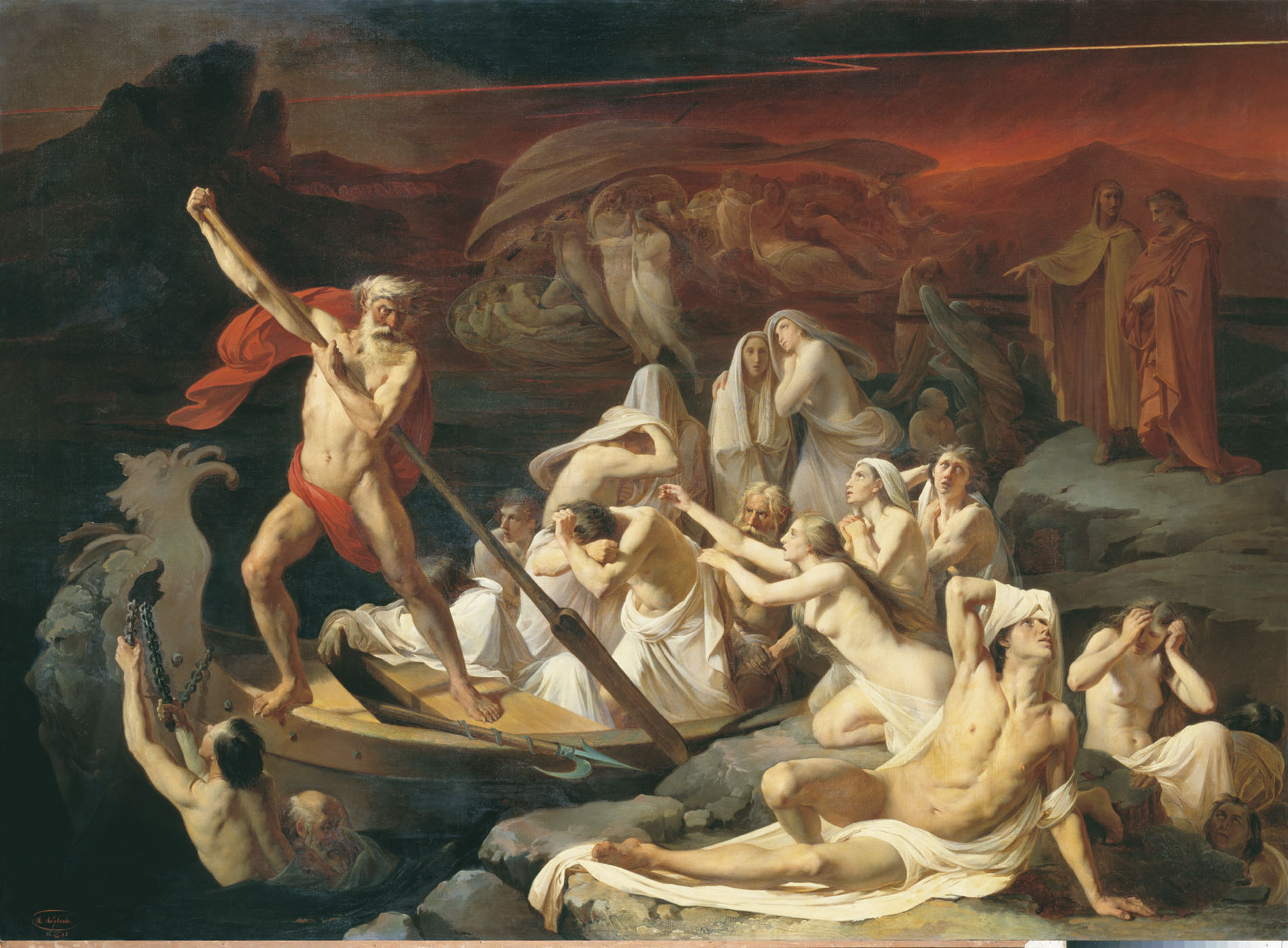
So that’s why we have an Athreos, God of Passage deck to play with this week. Take it away, Carl!
|
“Dear Azami,
I’ve been a fan of the column for a while now as well as many of the other Commander centric columns here on Star City. Some time ago I was reading an
The first thing I did was to read his abilities. In my distracted revelry I read his final ability as “Whenever another creature you own dies, return it to The current deck is as follows: Price for Passage: Creatures: Non-Creature Spells: Lands: 12 Plains 12 Swamps
I’m on a budget so Marsh Flats, Scrublands, Vindicate, etc are probably out of my price range…for now but any big bang for a few bucks that I can add to -Carl” |
This is a deck that shoots for a goal and basically lands it. Let’s see if we can help it out some more, bringing this sweet stack of cards a bit closer to
its Platonic Form.
The first step was to abandon the idea of sticking to a specifically Greek theology. Psychopomps are in many different religions, and gods in those
religions tend to be assisted by angels. Since there are a lot of relevant angels in black and white, I looked to see which of those I could bring in.
Next, I considered the tutors. Tutors are powerful, sure. They’re the best, most relevant card in your deck, but with the additional tutor price to cast
it. But I was trying to see, flavorfully, why Athreos, God of Passage, an entity that spends time with every human who dies on Theros, would need the
services of some random tutor, particularly the demonic ones who ze presumably outranks. I couldn’t see it, so I cut them.
I mean, that’s the downside of going all in on the flavor. Sometimes you have to cut powerful cards because they just don’t feel right. With the massive
cardset that Commander players pull from, there’s often a slightly more relevant, if less powerful, choice out there… even though it can sting to cut cards
that would be auto-includes in almost any other format.
Which is to say I also cut the removal that exiles an opposing permanent. I did this for two reasons. Flavorfully, I don’t see the God of Passage exiling
things. I think ze is more likely to take them to hell, so to speak, than send them off on a sweet trip to greener pastures (which is my impression of the
exile zone from cards like Path to Exile and Journey into Nowhere). Practically, with Athreos, God of Passage as your general, I thought you’d find the
removal a little stronger if it could be pointed at your own creatures from time to time as necessary to reset a Mulldrifter or get you an Athreos trigger.
There were other changes. I wasn’t wholly feeling the Church of Orzhova vibe, so I cut back on some of the underpowered extort cards. I still left in the
powerful ones (and added in Treasury Thrull, since the River Styx is a barrier between the living world and the greatest depository of treasure in the
Greek mythos), but if I were going hard on the extort theme I think I’d rather run Basilica Screecher and Thrull Parasite over Syndic of Tithes and Tithe
Drinker. The bat can hold off 1/1 flying tokens and the thrull can harass counter-based strategies. The syndic can’t block anything bigger than a 1/1
soldier token without dying, and the vampire can’t block without dying, period. I mean, okay, technically it could block a zero-power creature without
dying, but how often do those zero-power creatures swing in without some assistance from Bident of Thassa or Nettling Imp?
But enough background, let’s see what changes I made!
Lands:
Out (3):
In (4):
As you can see, I added in an extra land. One of these days I’m going to advise people to run less than 38 lands in a deck, but today is not that day. I
charted out your curve, and particularly after my changes, it tends to go a bit high. Since you want to be hitting your land drops every turn
(black/white’s primary means of ramping), you need to have plenty of lands in the first place.
I took out the cycling lands because I don’t think they’re a good fit for every deck. I like them in green decks with ways to recur them and in decks where
you don’t want to be drawing extra lands in the late game. With Athreos though, you’re going to be doing stuff and potentially a lot of it. I don’t think
there’s going to be a ton of points where you’re going to curse drawing a land, and running them if you don’t plan to do a lot of cycling just means you’re
running a comes-into-play-tapped land that doesn’t even have basic land typing. Less than ideal!
In their place, I added in Nykthos, Shrine to Nyx, which allows you to use your team’s devotion to rebuild immediately after you wrath; Tainted Field, a
dual that comes in untapped; Thespian’s Stage, the most useful utility land in that it’s all utility lands; and Vault of the Archangel, a way to get back
into games and trade your dudes up. While it’s not the same sort of draw effect you get from the cycling lands, it’s still card advantage.
As for the flavor, well, all life is a stage, and unless we walk through these tainted fields to find ourselves in the vault of god’s envoy, only then will
we find Nyx. Or something. Lands are hard!
Ramp:
Out (1):
In (4):
I didn’t love Caged Sun. I see why it’s worth running in two-color decks from time to time, especially with Urborg, Tomb of Yawgmoth, but I don’t think
what this deck needs is a six-mana ramp spell. (It’s not even a great anthem effect, since your tokens are mostly white, and you’re going to want to name
black with it because you’re running Urborg, Tomb of Yawgmoth.) I also wasn’t feeling the flavor, not that I did a great job on that front.
This is a mana rock deck. The white black color combination has some of the worst ramp options and some of the heaviest dudes. While there’s no super
flavorful way to solve this problem, it’s still worth running all the relevant rocks. Since many of your cards have a bunch of devotion symbols, it’s not
necessary to run Mind Stone or Prismatic Lens, but the full suite of Orzhov rocks and Sol Ring should help out in that regard.
Draw:
Out (3):
In (1):
So we’re back into the flavor section. It’s really hard to make the lands and the ramp, the basic bones of all these decks, conform to a specific theme
(unless that theme is monocolored “lands matter”). Lands just aren’t all that flavorful, or they have a very specific flavor that tends to tie into Magic’s
story elements.
Draw is flavorful though. And that’s one of the reasons I made these cuts. Yes, it’s probably cool to loop Moriok Replica, but that card is less good when
it reads “4B: draw two cards, lose two life, target opponent loses three life.” And that’s probably how it will play. Add in the fact it has no
underworldly connection, and it seems like we can do better for draw. Similarly, Athreos (and the archetype) aren’t really known for the type of demonic
deals that get signed in blood, and in a deck focused on creatures it seems like a wasted slot. Finally, there’s Disciple of Bolas. Bolas is evil. The
boatman is not traditionally evil. The only tie to the flavor of the deck is that it gives you the option to sacrifice another creature for power, and that
feels a little tangential in a card so clearly tied to a different archetype.
Graveborn Muse though, hits the right mark. It’s flavorful, in that it’s tied to death and the knowledge one draws from it, but it’s not particularly
evocative of anything that goes against the archetype. You have a servant, hanging out in the graveyards, learning information from the dead and passing it
on to you. I can get behind that, and I hope you can too.
Reanimation:
Out (3):
In (6):
Let’s talk archetype conflict in theme decks. I cut Phyrexian Delver because its flavor is openly tied to the Phyrexians. It’s the only flavor the card
has! But I don’t see the Phyrexians playing well with the boatman. Their whole shtick is about perverting life to avoid death, and I think a psychopomp
would find them viscerally offensive. But, one might ask, why then did you keep in Elesh Norn, Grand Cenobite, and add in Geth, Lord of the Vault? I did so
because they stand for more than just Phyrexia. Elesh Norn is the archetype of faith run amok, a belief in self-righteousness so absolute that it turns
back on itself. I can see how that religiosity plays with the border between life and death in a way that transcends her pure Phyrexianity. Geth, on the
other hand, is almost incidentally Phyrexian. Nyx, and its real world mythological counterpart Hades, are known for being repositories of wealth, and Geth
looks over those types of things. He feeds graveyards and he brings things back from the dead, a side effect of his own unholy reanimation. Those elements
make him seem more appropriate flavorwise, even if he does bear that Phyrexian stain.
Phyrexia. Phyrexia, Phyrexia, Phyrexia. Never type a made-up flavor word ten times in the same paragraph, it really begins to go all swirly if you do.
Adarkar Valkyrie is a strong inclusion, mechanically and flavorfully. Valkyries are psychopomps in their own right, even without this one being typed as an
angel. And practically she’s a ton of fun, since you can use her on your own creatures or on your opponents’. Definitely worth playing. Reya Dawnbringer is
a second Debtor’s Knell with the benefit of triggering Athreos should someone manage to get rid of her. Whip of Erebos is a last-resort reanimator with the
added benefit of the very relevant lifelink ability, and cards like Sepulchral Primordial give a lot of benefit even if they’re going to get exiled at the
end of turn.
Now, Profane Command is interesting. I added it in because it does a lot, most of it on theme, but I also like the flavor behind adding in the command
cycle. I mean, if Athreos tells you to get on the boat, you get on the boat! If ze tells you to go back and hang out with your living friends, you take the
upgrade. And if ze tells you to die… you die. It’s Simon Says, only Simon is a god who gets to keep you in limbo forever if you step out of line.
Recursion:
Out (5):
In (5):
As I mentioned before, I’m not a fan of the tutor flavor. The problem is that they add a lot of card advantage to your deck that you can’t just… ignore.
Take out something that strong, and you need to find something to fill the hole. I chose recursion.
Now, recursion is a slightly different beast from reanimation. Reanimation is all about bringing things back from the graveyard for immediate advantage,
whilst recursion is a subtler flavor of card advantage. Really, the line is super blurry, but the way I tend to visualize it is that reanimator cards
return things in the graveyard to the battlefield, while recursion cards require some sort of additional timing restriction or bring things back to your
hand. Reanimation is not always the better option, though, as there are definitely going to be times when you want to spend the mana now to have the option
to recast something after a Damnation or whatnot.
Cards like Cauldron of Souls and Twilight Shepherd provide backup for Athreos, God of Passage while being limited by certain timing restrictions, and
Treasury Thrull brings back all sorts of permanents your opponents may kill (while providing some backup for your extort plan). Angel of Serenity both
brings cards back to your hand from your graveyard while doubling as removal and graveyard hate (and I kinda love the flavor of serene acceptance in the
face of the neutrality of death). Champion of Stray Souls is a sac outlet that brings itself back from the ‘yard and reanimates if you have creatures to
feed it.
So it’s not perfect, but I think you’ll find these options are a bit more flavorful of a way to get card advantage,compared to the flat power levels of
your (admittedly good selection of) tutors.
Removal:
Out (10):
In (10):
I took out a bunch of your removal choices, and replaced them with things I found more flavorful. I think I’ve already mentioned not really feeling all
those one-for-one exile effects, since it feels off theme, but a few of the other cards raised similar issues. Just as Phyrexian Delver felt too Phyrexian
to be a good fit, Butcher of Malakir feels too vampiric to be a good fit. I mean, the vampiric undeath is all about immortality, unlike the zombie undeath
that’s about the separation of body and spirit; those spirits probably still make the passage. I don’t know, maybe that’s a less significant distinction to
you, but for me it seems odd.
Black Sun’s Zenith is just very Mirrodin and doesn’t really tap into any of the more general archetypes that Theros, with its Greek mythology themes, draws
from. Planar Cleansing is similarly unflavorful. Revoke Existence and Devouring Light exile but would probably be worth taking out even if they were on
theme, and then there’s Eater of Hope. I’ve found that card super underwhelming in Commander outside of dedicated token decks. So it’s out!
In its place, I brought in some of Orzhov’s powerful mulldrifters. If you’re in black and white and have some reanimation and recursion strategies, it
seems like a mistake to not play Angel of Despair and Ashen Rider. They’re both amazing at removing what ails you, and they’re both going to give you some
political options when they die; they’re often going to be the relevant removal for the biggest threat on the table, and that Athreos trigger can be
pointed at the person who most needs for you to remove it. Austere Command and Dictate of Erebos both call back to the flavor argument I made for Profane
Command, and they’re good replacements for Planar Cleansing and Butcher of Malakir, respectively. Day of Judgment and Life’s Finale are two wrath effects
that more closely tract with the duties of a psychopomp, and Sunblast Angel, Reaper from the Abyss, and Shadowborn Demon are all spot removal with ties to
the deck theme that also trigger Athreos when they die. That’s a three-for!
Finally there’s Killing Wave. There are many decks in which Killing Wave is a terrible card. As with any of the cards that give your opponent a choice,
they will invariably choose the worst choice for you. But that’s okay in a deck like this! In this deck you’re going to be fine with just draining your
opponents for a ton of life, since that means they’re going to be more receptive to saying “yes” to your Athreos triggers. When you start at 40 life, three
life is not a significant hit to take. When you drain them down to ten and sacrifice your board, pointing all the triggers at that player, well, there’s a
lot of incentive for them to play ball. Plus, it plays well with the primary card in the next section…
The Rest:
Out (7):
In (2):
One of the things I like about bringing the angels into the mix is that several of them are tied to emotional responses, and they tend to highlight the
wide variety of personal reactions we can have towards death. Some people face death with serenity, having lived a good life, knowing through faith that
there is something on the other side. Other people face it with despair, since the idea of our consciousness just ceasing to be can be absolutely
horrifying to face without the comfort of a magical eternal life. But for some people, usually those in great pain, death is something to be happy for.
That’s why Athreos isn’t evil; death isn’t evil. Death is a part of the cycle of life, and without it things lose some of their meaning.
Sorry to get heavy on y’all there. The point is, Angel of Jubilation is a good fit for the deck thematically, and it’s amazing mechanically. Angel of
Jubilation means Athreos always triggers in your favor, and it turns Killing Wave into a two-mana wrath. It also pumps the spirit tokens you get from
Teysa, Orzhov Scion and Lingering Souls, as well as many of your other angels. It’s a great card, and I’m glad to find room for it.
Cemetery Reaper is a little more borderline, but it’s graveyard control, and it generates tokens with a somewhat relevant creature type, so I think it’s
worth trying out. It’s certainly more on theme than Ogre Slumlord, which may give you a ton of tokens when you wrath, but they’re rat tokens, off theme and
not particularly powerful. Cartel Aristocrat just seemed weak as a pure sacrifice outlet, since a 2/2 with protection from the relevant colors isn’t
particularly strong on its own. I don’t love the extort creatures, as I mentioned above, and Sin Collector seems a lot less useful of a hand disruption
card than Corpse Traders, which I left in. And then there’s Divinity of Pride. I guess I can close my eyes and imagine it being in the deck on a flavor
level, but it’s a pure Baneslayer Angel. If you’re ahead, it’s an 8/8 with flying and lifelink, but it’s a lot less effective when you’re behind. Taking it
out gives us room for some more interesting options, and I don’t think you’re going to miss it all too much when it’s gone.
Which brings us to the updated list:
Creatures (35)
- 1 Ink-Eyes, Servant of Oni
- 1 Avatar of Woe
- 1 Hell's Caretaker
- 1 Nezumi Graverobber
- 1 Doomed Necromancer
- 1 Graveborn Muse
- 1 Reya Dawnbringer
- 1 Angel of Despair
- 1 Teysa, Orzhov Scion
- 1 Adarkar Valkyrie
- 1 Twilight Shepherd
- 1 Archon of Justice
- 1 Cemetery Reaper
- 1 Viscera Seer
- 1 Grave Titan
- 1 Geth, Lord of the Vault
- 1 Sunblast Angel
- 1 Massacre Wurm
- 1 Elesh Norn, Grand Cenobite
- 1 Rune-Scarred Demon
- 1 Reaper from the Abyss
- 1 Angel of Jubilation
- 1 Harvester of Souls
- 1 Corpse Traders
- 1 Odric, Master Tactician
- 1 Angel of Serenity
- 1 Treasury Thrull
- 1 Crypt Ghast
- 1 Sepulchral Primordial
- 1 Pontiff of Blight
- 1 Shadowborn Demon
- 1 Gray Merchant of Asphodel
- 1 Erebos, God of the Dead
- 1 Ashen Rider
- 1 Champion of Stray Souls
Lands (38)
Spells (26)
- 1 Wrath of God
- 1 Reanimate
- 1 Sol Ring
- 1 Necromancy
- 1 Victimize
- 1 Debtors' Knell
- 1 Orzhov Signet
- 1 Dread Return
- 1 Damnation
- 1 Austere Command
- 1 Profane Command
- 1 Cauldron of Souls
- 1 Day of Judgment
- 1 Elixir of Immortality
- 1 Caged Sun
- 1 Life's Finale
- 1 Unburial Rites
- 1 Lingering Souls
- 1 Killing Wave
- 1 Underworld Connections
- 1 Blind Obedience
- 1 Orzhov Keyrune
- 1 Orzhov Cluestone
- 1 Dark Prophecy
- 1 Whip of Erebos
- 1 Dictate of Erebos

As you can see, the creature count went up and the spell count went down. This seems right in a deck built around a commander who triggers upon the deaths
of your non-token creatures.
Financially, I managed to keep the changes relatively low this time around. I considered some cards like Deathbringer Liege that I ended up dismissing over
the cost… that card is not enough on theme to be worth $15, even though it is a ton of fun to play with. Other cards to consider would be Kukosho, the
Evening Star, and Hero’s Downfall, but again there’s an issue of straying a little off theme.
The total ended up being $67.48, although with a few of the cards their low prices means it’s a perfect opportunity to foil some things out. For example,
there’s a sweet game day full art foil for Killing Wave that is dirt-cheap… at least for a foil Magic card. Here’s the full list:
|
0.25 |
|
|
0.25 |
|
|
0.49 |
|
|
0.49 |
|
|
0.49 |
|
|
0.75 |
|
|
0.75 |
|
|
0.75 |
|
|
0.99 |
|
|
0.99 |
|
|
0.99 |
|
|
0.99 |
|
|
1.49 |
|
|
1.49 |
|
|
1.49 |
|
|
1.49 |
|
|
1.49 |
|
|
1.99 |
|
|
1.99 |
|
|
1.99 |
|
|
1.99 |
|
|
1.99 |
|
|
1.99 |
|
|
2.99 |
|
|
2.99 |
|
|
3.99 |
|
|
3.99 |
|
|
3.99 |
|
|
4.99 |
|
|
4.99 |
|
|
4.99 |
|
|
6.99 |
As always, Carl, you’ll be receiving a $20 credit to your Star City Games account for your submission; we’re always looking for interesting decks and
ideas, so the rest of you should drop us a line!
You gave me a lot to work with, and I hope you appreciate the direction I took things this week. I understand that a lot of people may be horrified by some
of the cuts I made, but my philosophy is that the design space for a Commander deck is huge, and it seems like it would be a shame to just play around with
the same 500 cards in every deck. Play some weird cards; it’s fun and people will appreciate seeing something new!
Want to submit a deck for consideration to Dear Azami? We’re always accepting deck submissions to consider for use in a future article. Only one deck
submission will be chosen per article, but being selected for the next edition of Dear Azami includes not just deck advice but also a $20 coupon to
StarCityGames.com!
Email us a deck submission using this link here!
Like what you’ve seen? Feel free to explore more of Dear Azami here, in the Article Archives!
And feel free to check Jess’s own Command of Etiquette
column on Hipsters of the Coast, for more Commander and casual content.

